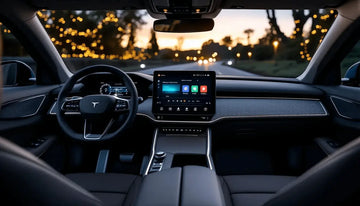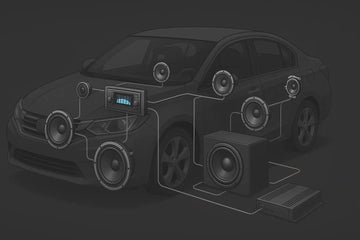Key Highlights
- Unleash the full potential of your car audio with an amplifier, boosting sound quality and volume.
- Discover the different types of car amplifiers, including mono, 2-channel, 4-channel, and multi-channel options.
- Learn about amplifier classes (A, B, AB, and D), each with pros and cons regarding sound quality and efficiency.
- Get familiar with the tools and accessories needed to install a car amplifier, ensuring a smooth DIY experience.
- Understand the key steps in installing a car amplifier, from planning the layout to connecting speakers and fine-tuning settings.
Introduction
Enhancing your car audio system can greatly improve your listening experience. The audio systems that come with cars may be fine for basic use. However, real music lovers often choose car amplifiers for the overall sound quality and best sound quality. Car amplifiers are important for boosting the sound and giving your music the extra power it needs. Let's look at car amplifiers and learn why they are key for anyone who takes their car audio seriously.
The Role of Amplifiers in Car Audio Systems
Imagine you are driving down the road with your favorite song on the radio. But the volume is low, the bass is weak, and the sound is not clear, especially with all the road noise. This is where car amplifiers come in. They work like a power booster for your car audio system. They take the weak audio signal from your head unit (car stereo) and strengthen it. This stronger signal then goes to your speakers. As a result, you get louder, clearer, and better sound.
In short, car amplifiers bring life to your music. They let you enjoy the depth and richness of your favorite songs. They help your speakers to perform better, giving you an audio experience that turns your everyday drive into a concert on wheels.
Boosting Sound Quality for the Ultimate Listening Experience
One main reason to invest in a car amplifier is the boost it gives to your car's audio system and sound quality. Factory-installed stereos usually have weak amplifiers. These are not strong enough for high-quality aftermarket speakers.
When you add an external amplifier, it gives your speakers a clean and strong signal. This helps them produce better sound. You will hear richer details, tighter bass, and a broader range of sounds. You will notice soft parts of your music that you couldn’t hear before, which will improve your listening experience.
If you like classical music, heavy metal, or anything else, a car amplifier will make your music better. It makes sure every note, beat, and voice comes through clearly and powerfully.
Why Every Car Audio System Needs an Amplifier
It’s true that not every car audio system needs an external amplifier. However, adding one can make a big difference in your sound quality, even if your speakers are still the same. Most factory stereos have weak built-in amplifiers. These built-in systems often can't deliver clear sound at high volumes.
An aftermarket amplifier can solve this problem. It gives a strong power source for your speakers. This means they get a clean audio signal, no matter how loud you play your music. As a result, you will hear much clearer sound and more details. You can enjoy your music without any distortion.
If you choose to upgrade your speakers later, having an amplifier becomes very important. Aftermarket speakers often need more power than what the factory stereo can give. An amplifier guarantees these speakers get enough power to work their best, resulting in less distortion and helping you experience the full depth and richness of your music.
Types of Car Amplifiers: Finding Your Perfect Match
Choosing the right car amplifier can feel overwhelming because of all the options out there. It’s helpful to learn about the different types of car amplifiers and what they do to make a good choice for your whole car audio system. There are small amplifiers that can boost your existing speakers. Then, there are large multi-channel amplifiers that can handle many speakers. You can find an amplifier that fits your needs.
If you want to add a subwoofer for deep bass, power a complete speaker system, or just improve the sound of your factory speakers, checking out the variety of car amplifiers is important. Doing so will help you create the perfect car audio experience.
From Mono to Multi-channel: Exploring Your Options
Car amplifiers are usually grouped based on their channel setup. This setup decides how many speakers they can support. For example, a mono amp is a single-channel amp. It mainly powers subwoofers because it boosts a lot of power to one channel.
A 2-channel amp works well for two speakers. A 4-channel amplifier can support two or one pair of speakers and one subwoofer. Multi-channel amplifiers, like 5-channel and 6-channel models, provide more options for advanced car audio setups.
Choosing the right amplifier depends on your needs. Think about how many speakers you will use, their needed power output, and your budget. This will help you find the best car amplifier for your system.
Understanding the Differences: Class A, B, AB, and D Amplifiers
Car amplifiers also differ in their amplifier class, which refers to the underlying technology used to amplify the audio signal. While several classes exist (A, B, AB, D), Class AB and Class D amplifiers dominate the car audio market. Class AB amplifiers, known for their good sound quality and affordability, use a combination of Class A and Class B design operations.
Class D amplifiers, on the other hand, prioritize efficiency and compact size. They utilize a switching design that minimizes heat generation, making them ideal for powering subwoofers and for use in space-constrained installations.
|
Amplifier Class |
Sound Quality |
Efficiency |
Size |
Cost |
|
Class A |
Excellent |
Low |
Large |
High |
|
Class AB |
Good |
Moderate |
Moderate |
Moderate |
|
Class D |
Good to Very Good |
High |
Compact |
Moderate to High |
Class D amplifiers have gained significant popularity in recent years due to their efficiency and compact form factor. They are now capable of delivering excellent sound quality while drawing less power from your car's electrical system.
Essential Equipment and Resources for Installing a Car Amplifier
Getting ready to set up a car amplifier can seem scary at the start. But, having the right tools, accessories, and resources makes it easier. Before you start the installation, you should collect everything you need. This helps to make the experience smooth and successful.
You will need basic tools like wire strippers and screwdrivers. You should also have special accessories, such as amplifier wiring kits and RCA cables. Being prepared helps you avoid delays. You can then focus on the fun of upgrading your car's audio system. Here’s a list of the key items you need to begin your diy car amplifier installation.
Tools and Accessories You'll Need to Get Started
- First, you will need some basic hand tools. These include a wire stripper/crimper, screwdrivers (both Phillips and flathead), pliers, and a wire cutter. These tools help you make secure connections in your car stereo system and route wires properly.
- Next, get an amplifier wiring kit. These kits usually have the right size power and ground cables, a fuse holder with a fuse, RCA cables for audio signal transfer, a speaker wire to connect your amplifier to the speakers, and different connectors and terminals.
- Also, think about getting a soldering iron and heat shrink tubing. These are for creating strong and insulated wire connections. Some other useful tools are a multimeter for checking continuity and voltage, zip ties or wire loom for keeping wires tidy, and a panel removal tool kit to reach the inside panels of your car.
Sourcing the Right Amplifier for Your Car’s Audio System
Selecting the right car audio amplifier is crucial for sound quality. Consider how much power your speakers can handle to match it with the amplifier output. Choose the number of channels based on your speaker setup, especially if adding a subwoofer. Ensure your car's electrical system can support the amplifier's power needs. Seek advice from experts or use resources like Crutchfield for product details and fitting parts.
Step-by-Step Guide to Installing Your Car Amplifier
With your tools and amplifier ready, it's time to start the installation process. A step-by-step plan helps you ensure that every connection is correct and safe, improving sound quality and preventing problems in the future.
By following these simple steps, you will be ready to enjoy a better car audio experience. Remember to check your car's manual and the amplifier’s installation guide for details about your parts and vehicle.
Step 1: Planning Your Installation Layout
Before you start installing the car audio system, take time to plan where you will place your parts. Find the best place for your amplifier, considering its size as well. Think about how easy it will be to reach, if it can breathe, and how close it is to the battery and speakers. Pick a spot that has enough space for the amplifier and its wires, and make sure there is good airflow to prevent it from getting too hot.
Next, think about how you will run your power and ground cables, RCA cables, and speaker wires. Plan the shortest and safest paths for each cable so you reduce the chance of interference and damage. You might want to use old wire paths or make new ones if necessary. Keep cables tied together and secure with zip ties or wire loom.
By planning your installation carefully, you will have a neat and professional look. This will also help you avoid noise and interference, so your car audio system works at its best.
Step 2: Connecting Power, Ground, and Remote Turn-on Wires
- Start by removing the negative terminal from your car battery. This helps to prevent electrical shorts while you install the system.
- Then, find a good grounding point on your vehicle's frame. Make sure it is clean and free of paint or rust.
- Attach the ground wire from your amplifier kit to this spot, and make it secure with a bolt or screw.
- Next, run the power cable from where your amplifier is to the positive terminal of your car battery. Use the right size wire as mentioned in your amplifier's manual.
- Place a fuse holder within 18 inches from the battery-positive terminal. Install the right fuse according to your amplifier’s power needs.
- Lastly, connect the remote turn-on wire from the amplifier to the remote turn-on lead on your car stereo. This makes sure the amplifier turns on and off along with the stereo.
- Before moving on to the next step, check all power connections to ensure they are tight and properly installed.
Step 3: Installing the Amplifier and Securing It in Place
With the power, ground, and remote turn-on wires connected, it is time to install the car amplifier. First, choose a spot that offers a strong surface and good airflow. You can place it under a seat, in the trunk, or on the back of a seat. Depending on where you pick, you may need to drill holes and use self-tapping screws to hold the amplifier securely.
Before you attach the amplifier for good, make sure all the cables can reach their connections comfortably. When you are happy with the placement and cable routing, attach the amplifier securely to the surface. Ensure it is stable so it won’t move while you drive.
Securing your amplifier properly will prevent damage to the unit. It will also reduce noise and vibrations that can affect sound quality.
Step 4: Connecting Speakers and Adjusting Settings for Optimal Sound
Now it is time to connect your car speakers to the amplifier, incorporating a passive crossover for optimal performance. Use the speaker wire from your wiring kit. Run separate wires from each speaker output to the right speaker. Make sure to connect the positive and negative terminals correctly. They should match the polarity of the amplifier and the speakers.
After connecting all speakers, you need to adjust the amplifier's gain settings and crossovers. This is important for good sound quality. Start with the gain set low. Slowly increase it until you notice a clean and clear sound at the volume you like.
Use the crossover settings to adjust the frequency range sent to each speaker. This helps create a balanced and clear sound. Feel free to play around with different settings to find what sounds best for you and works well with your car’s sound system.
Maximizing Your Car Amplifier's Performance
Installing a car amplifier is just the start. To really get the most out of it, you need to adjust its settings and follow some best practices. This will help improve its performance and lifespan. You have to learn about things like gain settings, crossover changes, and how to manage heat.
If you focus on these details and keep up with maintenance, your car amplifier will give you great sound quality. This way, it can be a trusted part of your audio system for many years.
Fine-Tuning for Clarity and Power: Adjusting Gain and Crossovers
Text:
To ensure clear and powerful sound from your amplifier, it's crucial to fine-tune gain settings. Gain control amplifies the input signal, with high levels causing distortion and low levels resulting in weak sound.
Crossovers act as sound filters, directing specific frequency ranges to appropriate speakers for improved clarity and reduced distortion.
Finding the optimal gain and crossover settings may require experimentation. Begin with lower levels and adjust gradually based on your preferences and the car's sound environment. For audio system calibration, utilize test tones or specialized music tracks.
Dealing with Overheating: Causes and Solutions
One big problem with car amplifiers is overheating. This can happen for different reasons, such as not enough airflow, too high gain settings, impedance mismatches with the speakers, or a broken amplifier.
If your amplifier keeps getting hot, check where you have it installed. Make sure there is enough space for air to flow around it. Also, look at the gain settings. If they are too high, the amplifier works harder than it should.
If your amplifier still overheats after improving airflow and adjusting gain, check the impedance between it and the speakers. If these do not match, it can cause too much current draw and heat. If these steps do not fix the problem, you may need to see a technician or consider getting a new amplifier.
Frequently Asked Questions
How do I know if my car needs an amplifier?
If your car audio sounds distorted at high volumes, has little bass, or does not sound great, then you might need a car amplifier. An amplifier could improve the weak audio signal from your factory system. Getting a separate amplifier is often the first step to better sound quality and a richer listening experience.
Can I install a car amplifier myself?
Yes! You can install a car audio system yourself. You need the right tools, some research, and the confidence to start. Many online resources and guides can help you through the steps.
What are the signs of a failing car amplifier?
Symptoms of a bad car amplifier include sound that stops and starts, fuzzy audio at any volume, no sound at all, overheating even with good airflow, or a burning smell. If you have these problems, you should check your amplifier. You can also get help from a pro.





